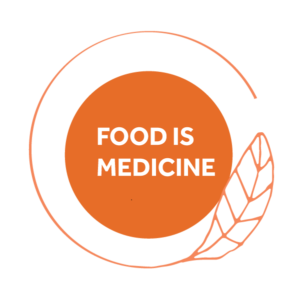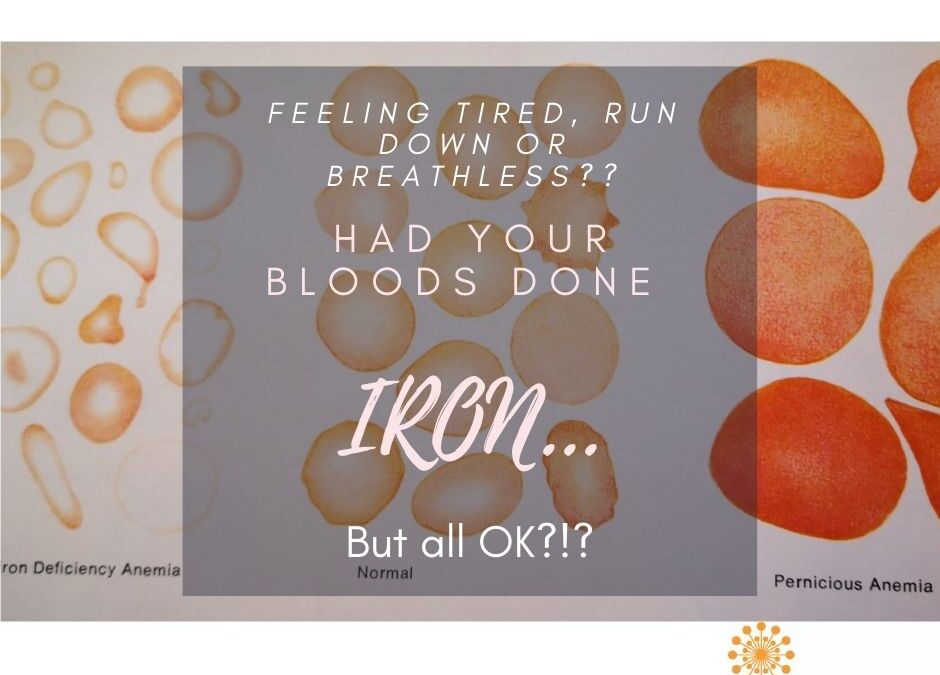Let’s get talking about Iron & Your Blood Results….

Time & time again I see patients presenting with iron deficiency symptoms, but they may have been to the doctor where they receive only a Full Blood Count (FBC) blood test or maybe a finger stick blood test to check what their Haemoglobin (Hb) levels are. If this is in range the doctor often says all is ok & to maybe ‘just eat more red meat’ if they are feeling tired, dizzy etc when there is no other obvious cause for concern.
Occasionally they will do just a Ferritin check – with sometimes this being just within range they say ’all is fine’. Sometimes your concerns might be misdiagnosed (& a cardiac or pulmonary referral given) or incorrectly treated with medication for another ailment (i.e. anxiety, depression) when what you really need to be treated for is iron deficiency. Iron deficiency can develop quite slowly & even affect hormones, & did you know there can be a family history linked to many forms of anaemia??
So why is it I get concerned when I have a woman in front of me with a ‘normal’ Hb, & a low-normal ferritin level but no full panel of iron studies?? Well to understand this you need to understand a few terms & what they mean.
What is haemoglobin?
Haemoglobin (Hb) is a protein that can be found in red blood cells which binds to iron, where its primary function is to transport oxygen to the tissues in your body & to remove carbon dioxide from the tissues to the lungs. All tissues require oxygen to survive. Haemoglobin can be low due to many reasons including pregnancy, liver problems, infections, inflammation, blood loss, gut malabsorption concerns & of course iron deficiency anaemia.
What is the difference between iron, haemoglobin & ferritin?
It is a common misconception that iron, haemoglobin & ferritin are the same thing. This is incorrect. Iron is a component of haemoglobin & is also found in other parts of the body. Unlike other minerals in the body, iron levels are controlled exclusively by absorption – so especially if you have any gut concerns (diarrhoea, coeliac, Crohn’s disease, parasites, haemorrhoids etc) it’s important to know you may be iron deficient. It is possible to have a normal haemoglobin level but be lacking in iron. Iron is essential for your body to function normally & to make haemoglobin. Ferritin is a iron-storage protein found in the blood & indicates 25% of your iron reserve. This level can also be raised due to infection & inflammation – hence a full iron studies is ideal.

What is Anaemia?
Anaemia is a household word & it’s often used interchangeably with the term “low iron.” However, contrary to popular belief, anaemia & low iron or iron deficiency are not always the same. There are various subsets of anaemia, which we won’t go into here…but I’m happy to review your individual case at an appointment – simply book online.
Let’s break it down:
- Anaemia is caused by lack of Haemoglobin.
- Iron Deficiency is caused by lack of Iron.
- Iron Deficiency with Anaemia is caused by both a lack of Iron AND a lack of Haemoglobin.
- Iron Deficiency without Anaemia is the same thing as Iron Deficiency & is caused by lack of Iron, but Haemoglobin is still normal.
So…you can have anaemia (low haemoglobin) without having iron deficiency. Likewise, you can have iron deficiency without having anaemia.
Iron Deficiency symptoms include:
- Feeling tired, listless & weak
- Breathlessness
- Poor memory & concentration
- Poor performance at school or work
- Getting infections easily
- Finding it difficult to do aerobic exercise
- Behaviour problems in children
- Decreased libido (sex drive)
As you can see below, there are similar symptoms with Iron Deficiency Anaemia – but it’s also important to know that these symptoms can also be caused by other health conditions, so always seek health advice from your trusted professional.
So, what are the signs of Iron Deficiency Anaemia?
- Low ferritin
- Extreme fatigue & weakness
- Headaches
- Dizziness & light-headedness
- Fainting
- Rapid heartbeat or heart palpitations/flutters
- Chest pain
- Shortness of breath – after simple tasks such as climbing stairs, walking short distances, rushing around
- Cold hands &/or feet – low body temperature, unable to get & stay warm
- Pica (an intense craving to chew ice or non-food items)
- Hair loss
- Restless Legs Syndrome – legs tingling, twitching, moving uncontrollably, especially when you go to bed
- Pale skin &/or pale areas inside of the eyelids, mouth & cheeks
- Blue sclera – white part of eyes can take on a bluish tint
- Sore, pale or inflamed tongue
- Nail abnormalities – brittle, spooned, ridged, streaked
- Whooshing or pounding sound or ringing in ears – can hear your heartbeat in your ears
- Irritability
- Foggy thinking, poor memory
- Depression & loss of interest in things you normally care about
On the flipside…High haemoglobin levels
High haemoglobin can be caused by dehydration, smoking, living at high altitudes, or it can be linked to other conditions, such as lung or heart disease.
High haemoglobin levels could also be indicative of the rare blood disease, polycythaemia. It causes the body to make too many red blood cells, causing the blood to be thicker than usual. It also makes it harder for your red blood cells to carry oxygen too. This can potentially lead to clots, heart attacks & strokes. It is a serious lifelong condition which often goes unnoticed & can be fatal if it is not treated. There are other markers in your blood results which will also need to be out of the ‘normal range’, & further investigations to consider – so it is important for your health professional to go through any blood test results you have & explain any discrepancies.
Stay tuned for future blogs…..

References:
Iron Deficiency Anaemia | Ironology Health Solutions
Iron in Infection & Immunity; Manfred Nairza, GünterWeiss – Molecular Aspects of Medicine Oct 2020
Polycythaemia & High Haemoglobin
The Morphology of Human Blood Cells, 5th edition – L. W. Diggs (MD); Dorothy Strum; Ann Bell
Hutchison’s Clinical Methods, 20th edition – Michael Swash (MD)
Inter Clinical Professional Monograph Series – Iron
Principles of Anatomy & Physiology, 8th edition – Gerard Tortora; Sandra Reynolds Grabowski

